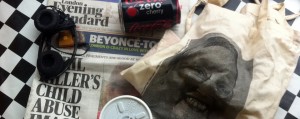Over the last decade our beloved music industry has been changing, “evolving”, desperately adapting to the new web era and consumer patterns. Apple leading, record labels following. These days it feels like the transformation is nearly complete and everyone wants to join (Amazon recently, Google next….).
For musicians this doesn’t necessarily mean higher profits as new intermediaries have appeared but at least it’s now possible for any sound artist to produce a track at home, make a quick and totally inexpensive video and send it off to the blogosphere …. test it. The following day a few of those blogs will write about it and many others will re-post, punters will share on their facebook profiles… press “like” buttons and generally spread the word… in the best of cases (and get notice by thirsty talent seekers). This is especially useful for us “fringe artists”.
The good thing about this “democratization” (in every single and possible way) is that most music makers have now access to a wide number of web-based publishing tools (bandcamp, soundcloud, vimeo…etc) to get out there and make themselves known. However audiences can choose at the same time amongst an ever increasing on-line music offer and libraries with frillions of songs within a couple of clicks. There’s even an excess indie blog supply which seem cluttered with anything and everything proposing hundreds of new potential “talents” every day. Mainstream artists may keep having astronomical budgets and sizeable PR teams behind them (think Gaga), but underground artists now enjoy an access to web instruments that may produce the same result as a good PR team.
It’s refreshing to think we now have true choice, as opposed to being mere consumers of what the top 3-4 record companies try to ram down our collective throats. MTV or Kiss FM may have lost their monopolistic influence… but aren’t Pitchfork, Drowned or Rockdelux the new NME, Rolling Stones or Mojo?
Everything is migrating and media corporations are playing very hard to catch-up with our new ways of culture consumption. We used to discover an “underground band” and enjoy them throughout a whole month before finding something sharper. Now we discover “Is Tropical” and enjoy them for an hour before reading the next best proposal. There’s too much offer… because since Myspace came out… (and now about to die) pretty much any musician has the same probability of succeeding (ok, maybe not… but you get the idea).
There used to be a very clear distinction between those two markets: you’re either an underground artist and work as a barista or a mainstream one and hover money through your nose. Black or white for better or worse (no matter how many sub-genres or signifiers you may incorporate). What’s interesting now is that the promotion platforms for both are essentially the same. You used to need your label to have sufficient budget for payola, or in other words, to be able to pay the elitist channels to play your artists’ music or video. Music that was harder to market easily fell under the cracks. Alternative culture does not need said channels of promotion any longer.
So this paints a tiny picture of how music PR has changed over the past few years and where we are now. However, there is still the problem that precisely because of the web, consumers tend to have shorter attention spans. I feel it is no longer enough to record a track and send it off for the world to hear. So one thing I did with a few friends was to join the “one track – one clip” trend many artists have popularized nowadays (PJ Harvey is the last & best example but many like Chemical Brothers, Jonna Lee recently or Blondie & Split Enz in the past). We feel this will demand people’s attention by submerging them more into the music than just passive listening.
In keeping with the independent DIY spirit, no-one needs a big corporation budget to produce or distribute art, in fact new bands ask for rather cheaper video-artists and video-sampling masters such as Paris-based “Jamie Harley” (behind some of the latest big video-art vintage hits on the net… Twin Shadow, Memory House, ANR, Museum of Bellas Artes….) The Tearist or many musicians themselves (look for FAMILY, Happy trendy…). Obviously what we do is directed at a niche market, but this is one that is now easily catered to, enabling us to reach out in ways that were previously impossible. And with this new concept, our combination of music and video art brings a multimedia experience to your screen and speakers, and a generally more engaging listening experience for our music.
Amateur directors (or pretty much anyone) make the videos on their own by collecting found footage and bits of old cult films. The access to (a)legal copies of video-editing software (premiere, after-effects…) allows us to creatively edit these clips and apply effects to the visuals to suit the music. Films may be re-arranged to tell a different narrative than that of the original story. It is all done to compliment the music and we are no longer hung up on making albums and expecting people to listen to them all the way through as would be our intention.
Clearly the days of “Dark Side of the Moon” are long behind us, and anyone can now bring out new singles with accompanying videos as we bang them out.
















